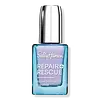What's inside
What's inside
 Key Ingredients
Key Ingredients

 Benefits
Benefits

 Concerns
Concerns

 Ingredients Side-by-side
Ingredients Side-by-side

Butyl Acetate
MaskingEthyl Acetate
PerfumingNitrocellulose
Acetyl Tributyl Citrate
MaskingAdipic Acid/Neopentyl Glycol/Trimellitic Anhydride Copolymer
Isopropyl Alcohol
SolventAcrylates Copolymer
Stearalkonium Bentonite
Gel FormingHydrogenated Castor Oil/Sebacic Acid Copolymer
EmollientStyrene/Acrylates Copolymer
Benzophenone-1
UV AbsorberCI 77891
Cosmetic ColorantPrunus Armeniaca Kernel Oil
MaskingCocos Nucifera Oil
MaskingPersea Gratissima Oil
Skin ConditioningCaprylic/Capric Triglyceride
MaskingPassiflora Edulis Seed Oil
EmollientHexanal
MaskingPropanediol
SolventWater
Skin ConditioningLauraldehyde
MaskingPassiflora Incarnata Seed Oil
Skin ProtectingSalicornia Herbacea Extract
Skin ConditioningCI 77491
Cosmetic ColorantMyrothamnus Flabellifolia Extract
HumectantAcetyl Methionine
Skin ConditioningAcetyl Cysteine
AntioxidantPolyurethane-67
Methoxyisopropyl Acetate
SolventCitric Acid
BufferingButyl Acetate, Ethyl Acetate, Nitrocellulose, Acetyl Tributyl Citrate, Adipic Acid/Neopentyl Glycol/Trimellitic Anhydride Copolymer, Isopropyl Alcohol, Acrylates Copolymer, Stearalkonium Bentonite, Hydrogenated Castor Oil/Sebacic Acid Copolymer, Styrene/Acrylates Copolymer, Benzophenone-1, CI 77891, Prunus Armeniaca Kernel Oil, Cocos Nucifera Oil, Persea Gratissima Oil, Caprylic/Capric Triglyceride, Passiflora Edulis Seed Oil, Hexanal, Propanediol, Water, Lauraldehyde, Passiflora Incarnata Seed Oil, Salicornia Herbacea Extract, CI 77491, Myrothamnus Flabellifolia Extract, Acetyl Methionine, Acetyl Cysteine, Polyurethane-67, Methoxyisopropyl Acetate, Citric Acid
Ethyl Acetate
PerfumingButyl Acetate
MaskingNitrocellulose
Acrylates/Hydroxyesters Acrylates Copolymer
Acetyl Tributyl Citrate
MaskingIsopropyl Alcohol
SolventTosylamide/Epoxy Resin
N-Butyl Alcohol
PerfumingAcetylated Hydrogenated Castor Glyceride
Stearalkonium Hectorite
Gel FormingBenzophenone-1
UV AbsorberCaprylic/Capric Triglyceride
MaskingMethyl Methacrylate Crosspolymer
Dimethicone
EmollientApium Graveolens Seed Extract
AntioxidantCitric Acid
BufferingWater
Skin ConditioningAdipic Acid/Neopentyl Glycol/Trimellitic Anhydride Copolymer
Amethyst Extract
Skin ConditioningBiotin
AntiseborrhoeicTocopherol
AntioxidantLeuconostoc/Radish Root Ferment Filtrate
AntimicrobialCI 77891
Cosmetic ColorantCI 15880
Cosmetic ColorantCI 60725
Cosmetic ColorantCI 15850
Cosmetic ColorantCI 77510
Cosmetic ColorantEthyl Acetate, Butyl Acetate, Nitrocellulose, Acrylates/Hydroxyesters Acrylates Copolymer, Acetyl Tributyl Citrate, Isopropyl Alcohol, Tosylamide/Epoxy Resin, N-Butyl Alcohol, Acetylated Hydrogenated Castor Glyceride, Stearalkonium Hectorite, Benzophenone-1, Caprylic/Capric Triglyceride, Methyl Methacrylate Crosspolymer, Dimethicone, Apium Graveolens Seed Extract, Citric Acid, Water, Adipic Acid/Neopentyl Glycol/Trimellitic Anhydride Copolymer, Amethyst Extract, Biotin, Tocopherol, Leuconostoc/Radish Root Ferment Filtrate, CI 77891, CI 15880, CI 60725, CI 15850, CI 77510
Ingredients Explained
These ingredients are found in both products.
Ingredients higher up in an ingredient list are typically present in a larger amount.
Acetyl Tributyl Citrate is a fragrance.
We don't have a description for Adipic Acid/Neopentyl Glycol/Trimellitic Anhydride Copolymer yet.
Benzophenone-1 absorbs UV.
We don't have a description for Butyl Acetate yet.
This ingredient is an emollient, solvent, and texture enhancer. It is considered a skin-softener by helping the skin prevent moisture loss.
It helps thicken a product's formula and makes it easier to spread by dissolving clumping compounds.
Caprylic Triglyceride is made by combining glycerin with coconut oil, forming a clear liquid.
While there is an assumption Caprylic Triglyceride can clog pores due to it being derived from coconut oil, there is no research supporting this.
Learn more about Caprylic/Capric TriglycerideCi 77891 is a white pigment from Titanium dioxide. It is naturally found in minerals such as rutile and ilmenite.
It's main function is to add a white color to cosmetics. It can also be mixed with other colors to create different shades.
Ci 77891 is commonly found in sunscreens due to its ability to block UV rays.
Learn more about CI 77891Citric Acid is an alpha hydroxy acid (AHA) naturally found in citrus fruits like oranges, lemons, and limes.
Like other AHAs, citric acid can exfoliate skin by breaking down the bonds that hold dead skin cells together. This helps reveal smoother and brighter skin underneath.
However, this exfoliating effect only happens at high concentrations (20%) which can be hard to find in cosmetic products.
Due to this, citric acid is usually included in small amounts as a pH adjuster. This helps keep products slightly more acidic and compatible with skin's natural pH.
In skincare formulas, citric acid can:
While it can provide some skin benefits, research shows lactic acid and glycolic acid are generally more effective and less irritating exfoliants.
Most citric acid used in skincare today is made by fermenting sugars (usually from molasses). This synthetic version is identical to the natural citrus form but easier to stabilize and use in formulations.
Read more about some other popular AHA's here:
Learn more about Citric AcidEthyl Acetate is a fragrance.
Isopropyl Alcohol is more commonly known as rubbing alcohol. It is most commonly used as a solvent, meaning it helps other ingredients dissolve.
This ingredient is an astringent alcohol. Astringent alcohols may also irritate skin as they high amounts may strip away your skin's natural oils.
Other types of astringent alcohols include:
According to the National Rosacea Society based in the US, you should be mindful of products with these alcohols in the top half of ingredients.
Any type of sanitizing product will have high amounts of alcohol to help kill bacteria and viruses.
Learn more about Isopropyl AlcoholWe don't have a description for Nitrocellulose yet.
Water. It's the most common cosmetic ingredient of all. You'll usually see it at the top of ingredient lists, meaning that it makes up the largest part of the product.
So why is it so popular? Water most often acts as a solvent - this means that it helps dissolve other ingredients into the formulation.
You'll also recognize water as that liquid we all need to stay alive. If you see this, drink a glass of water. Stay hydrated!
Learn more about Water